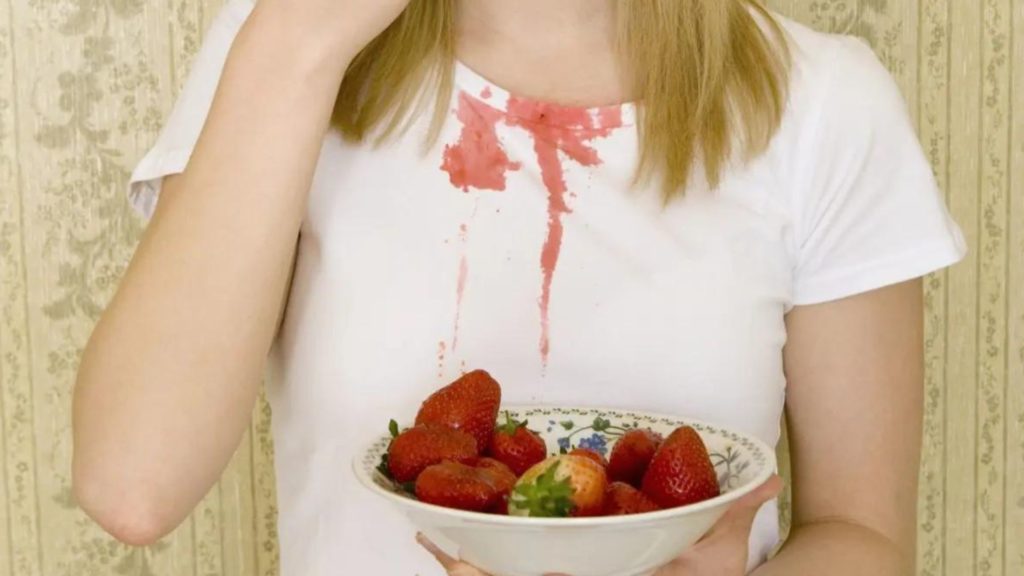Nothing brings joy quite like enjoying a juicy strawberry on a warm summer day. However, these delightful berries can leave an unexpected mark on your clothes, carpets, or furniture: unsightly strawberry stains.

Image: www.pinterest.com
The Enigma of Strawberry Stains
Strawberry stains are stubborn due to the presence of natural colorants called anthocyanins, which bind strongly to fabrics. These pigments, responsible for the berry’s vibrant red hue, can penetrate deeply, making stain removal a formidable challenge.
The Dance of Acidity and Enzymes
Tackling strawberry stains requires a multifaceted approach. Understanding the chemical makeup of these stains is crucial. Strawberries are acidic, so a solution with a higher pH can help neutralize the acidity, loosening the pigment’s grip on the fabric.
Enzymes are nature’s cleaning powerhouses. Stain-removing products often contain enzymes like protease and pectinase, which break down the proteins and pectin present in strawberry stains, allowing them to be more easily washed away.
When Time is of the Essence: Fresh Stains
As with most stains, prompt action is the key to success. Here’s a simple yet effective method:
- Rinse with Cold Water: Flush the stained area with cold water as soon as possible to prevent the stain from setting in.
- Apply Baking Soda Paste: Create a paste by mixing baking soda with a little water. Apply the paste directly to the stain and let it sit for a few minutes.
- Time for Vinegar: Pour white vinegar over the stain and allow it to rest for another few minutes.
- Rinse Thoroughly: Finally, rinse the area with plenty of cold water to remove any remaining residue.

Image: www.byebyestains.com
Conquering Set-In Stains: A Path to Victory
For stains that have had time to set in, employing a more robust approach is necessary:
- Hydrogen Peroxide Solution: Mix 3% hydrogen peroxide with an equal amount of water. Apply to the stain using a clean cloth and let it sit for no more than 30 minutes, as prolonged exposure can damage some fabrics.
- Lemon Juice Magic: Combine equal parts lemon juice and water. Apply the solution to the stain and let it sit for 15-20 minutes.
- Enzyme-Based Laundry Detergent: Opt for a laundry detergent that contains enzymes specifically designed to combat food stains, such as protease and pectinase.
- Patience and Perseverance: Stains may require multiple treatments and patience. Repeat the process as needed until the stain is completely removed.
Maintenance and Prevention: A Path to Stain-Free Bliss
- Act Quickly: The faster you address a strawberry stain, the higher your chances of complete removal.
- Test First: Before applying any stain removal technique, test on an inconspicuous area to ensure it doesn’t damage the fabric.
- Avoid Bleach: Bleach may damage some fabrics and set certain stains, rendering them even more stubborn.
- Learn from the Past: Protect clothing and surfaces by wearing an apron or tablecloth when indulging in strawberry-rich treats.
Strawberry Stain FAQ
Q: Why are strawberry stains so hard to remove?
A: Strawberry stains contain anthocyanins, which are pigments that bind strongly to fabric. The acidic nature of strawberries can also make stains more difficult to remove.
Q: What is the best way to remove a fresh strawberry stain?
A: Flush the stain with cold water and apply a baking soda paste, followed by white vinegar. Rinse thoroughly.
Q: How do I remove a set-in strawberry stain?
A: Try hydrogen peroxide solution, lemon juice solution, or an enzyme-based laundry detergent. Multiple treatments may be necessary for complete removal.
How To Get Out Strawberry Stain
Conclusion
Armed with the knowledge and techniques outlined above, you can bid farewell to unsightly strawberry stains. Whether fresh or set-in, these methods will help restore your fabrics to their former glory. Remember, prompt action, strategic application of products, and a dash of patience are the keys to victory in the battle against strawberry stains.
Are you ready to embrace stain-free bliss?







